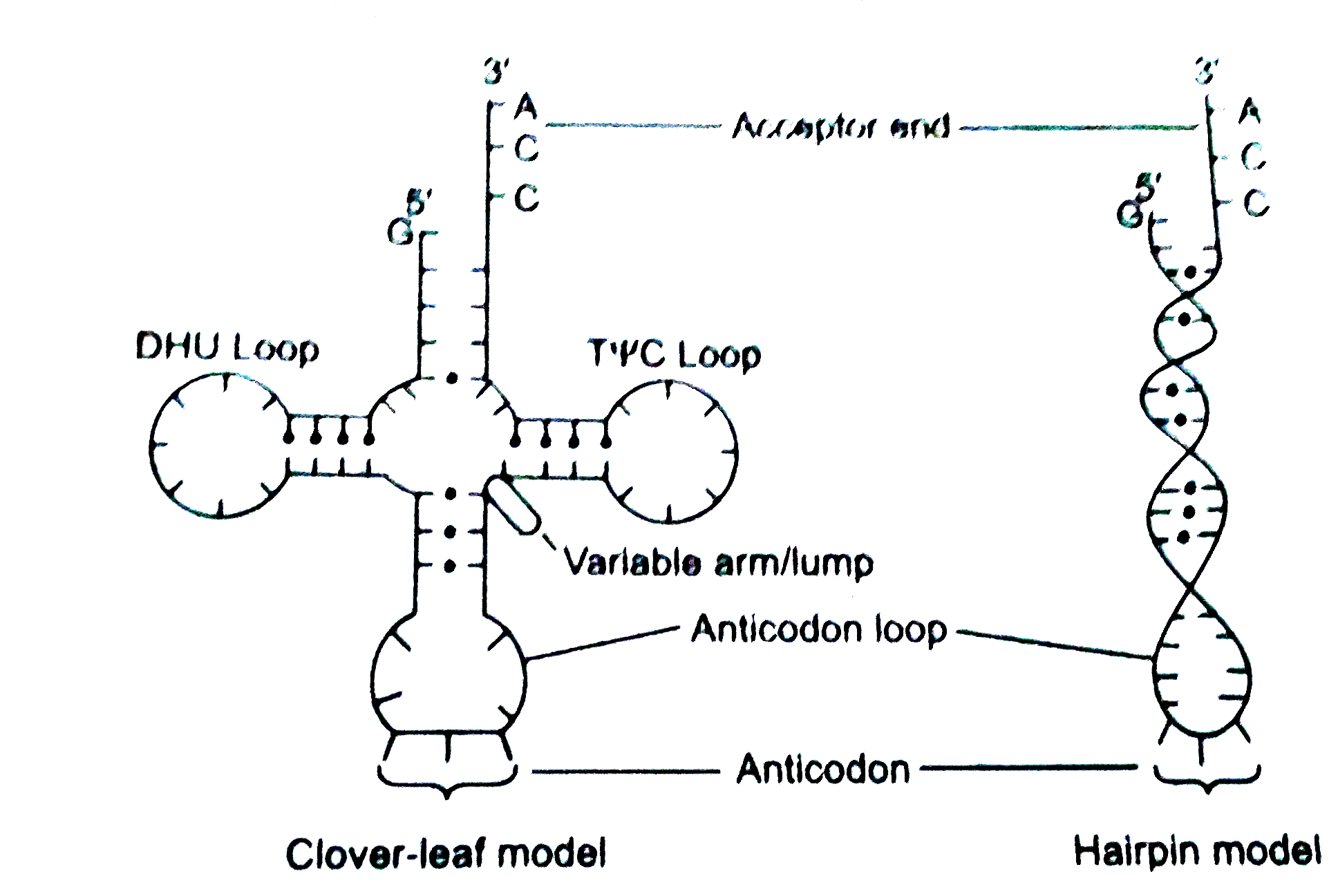What is 'RNA' ? Explain different types of non-genetic RNA with diagrams and functions.
Text Solution
RNA (Ribonucleic acid) is a type of nucleic acid found in the nucleus as well as in the cytoplasm.
Non-genetic RNA : It is mainly involved in protein. There are three different types of non-genetic RNA as follows :
(a) Messenger RNA (m-RNA) :
(i) It is produced on the DNA strand inside nucleus by a process called transcription and then transferred to cytoplasm.
(ii) It is called messenger RNA because it carries message for protein synthesis from DNA to the ribosomes in the form of codons.
(iii) It constitutes about 3−5% of the total RNA content of the cell.
(iv) Molecular weight of an average size m-RNA is about 5,00,000.
(v) It is always single stranded, linear and straight (unfolded).
(vi) It has two ends as 5' end and 3' end. At 5' end it bears a cap of methylated guanine. This cap is followed by initiation codon and at 3' end are present many adenine type nucleotides.
(vii) A triplet of nucleotides on m-RNA is called codon.
(viii) Each codon on m-RNA specifies one amino acid. This is called m-RNA language or genetic code or cryptogram.
(ix) The codon present at 5' end of m-RNA is called initiation codon or start codon. The common initiation codon is AUG or in some cases GUG.
(x) The codon present at 3' end is called termination codon or stop codon or non-sense codon. The termination codon may be UAA or UAG or UGA.
Function of m-RNA :
(i) It carries genetic information from DNA to ribosomes during protein synthesis.
(ii) The genetic code of m-RNA gets translated into the sequences of amino acids to form proteins.
(b) Ribosomal RNA (r-RNA):
(i) It is present in ribosomes, hence, the name ribosomal RNA.
(ii) It consists of a single strand. The single strand is folded upon itself in certain region.
(iii) In folded regions, complementary base pairing occurs while in unfolded region it is absent.
Function of r-RNA :
(i) It provides proper binding sites for m-RNA on the ribosomes.
(ii) It orients m-RNA molecule in such a way that all the codons are properly read.
(iii) It releases t-RNA molecules after transfer of activated amino acid to polypeptide chain.
(iv) It also protects the proteins molecule under construction.
(v) It also protects m-RNA from RNA Ase enzyme.
(c) Transfer (t-RNA) or Soluble RNA (s-RNA) :
(i) It is the smallest of the three types of nongenetic RNA.
(ii) It transfers activated amino acid to the site of protein synthesis. Hence, it is called transfer RNA.
(iii) It is also called soluble RNA as these molecules cannot be separated from cytoplasm even by ultra centrifuge technique.

t-RNA structure
|
Topper's Solved these Questions
- MARCH 2017Book:GURUKUL PUBLICATION - MAHARASHTRA PREVIOUS YEAR PAPERSChapter: MARCH 2017Exercise:SECTION-II
Explore 24 Videos
- MARCH 2016Book:GURUKUL PUBLICATION - MAHARASHTRA PREVIOUS YEAR PAPERSChapter: MARCH 2016Exercise:SECTION-II
Explore 24 Videos
- MARCH 2018Book:GURUKUL PUBLICATION - MAHARASHTRA PREVIOUS YEAR PAPERSChapter: MARCH 2018Exercise:SECTION-II
Explore 24 Videos
Similar Questions
Knowledge Check
Genetic RNA is
AGenetic material of RNA virusesBRNA that carries genetic messageCRNA that helps gene regulation in lac operonDRNA present in mitochondriaNon - genetic RNA is of
ATwo typesBThree typesCOnly one typeDNone of theseWhich one is non-genetic RNA
AtRNABrRNACmRNADAll the above
Explain the types of RNA.
View SolutionName different types of RNA found in the cell. State one function of each.
View SolutionWhat are the different types of RNA found in the cell?
View SolutionWhat are the different types of RNA found in the cell ?
View SolutionWhat are the different types of RNA found in the cell?
View Solution
